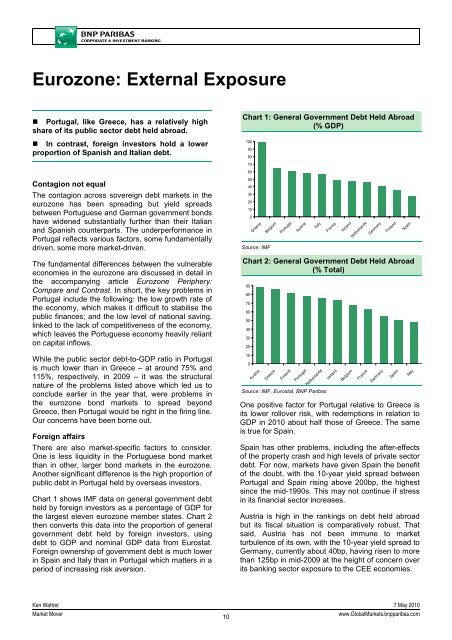Market Economics | Interest Rate Strategy - BNP PARIBAS ...
Market Economics | Interest Rate Strategy - BNP PARIBAS ...
Market Economics | Interest Rate Strategy - BNP PARIBAS ...
Create successful ePaper yourself
Turn your PDF publications into a flip-book with our unique Google optimized e-Paper software.
Eurozone: External Exposure<br />
• Portugal, like Greece, has a relatively high<br />
share of its public sector debt held abroad.<br />
• In contrast, foreign investors hold a lower<br />
proportion of Spanish and Italian debt.<br />
Chart 1: General Government Debt Held Abroad<br />
(% GDP)<br />
100<br />
90<br />
80<br />
70<br />
60<br />
Contagion not equal<br />
The contagion across sovereign debt markets in the<br />
eurozone has been spreading but yield spreads<br />
between Portuguese and German government bonds<br />
have widened substantially further than their Italian<br />
and Spanish counterparts. The underperformance in<br />
Portugal reflects various factors, some fundamentally<br />
driven, some more market-driven.<br />
50<br />
40<br />
30<br />
20<br />
10<br />
0<br />
Greece<br />
Belgium<br />
Source: IMF<br />
Portugal<br />
Austria<br />
Italy<br />
France<br />
Ireland<br />
Netherlands<br />
Germany<br />
Finland<br />
Spain<br />
The fundamental differences between the vulnerable<br />
economies in the eurozone are discussed in detail in<br />
the accompanying article Eurozone Periphery:<br />
Compare and Contrast. In short, the key problems in<br />
Portugal include the following: the low growth rate of<br />
the economy, which makes it difficult to stabilise the<br />
public finances; and the low level of national saving,<br />
linked to the lack of competitiveness of the economy,<br />
which leaves the Portuguese economy heavily reliant<br />
on capital inflows.<br />
While the public sector debt-to-GDP ratio in Portugal<br />
is much lower than in Greece – at around 75% and<br />
115%, respectively, in 2009 – it was the structural<br />
nature of the problems listed above which led us to<br />
conclude earlier in the year that, were problems in<br />
the eurozone bond markets to spread beyond<br />
Greece, then Portugal would be right in the firing line.<br />
Our concerns have been borne out.<br />
Foreign affairs<br />
There are also market-specific factors to consider.<br />
One is less liquidity in the Portuguese bond market<br />
than in other, larger bond markets in the eurozone.<br />
Another significant difference is the high proportion of<br />
public debt in Portugal held by overseas investors.<br />
Chart 1 shows IMF data on general government debt<br />
held by foreign investors as a percentage of GDP for<br />
the largest eleven eurozone member states. Chart 2<br />
then converts this data into the proportion of general<br />
government debt held by foreign investors, using<br />
debt to GDP and nominal GDP data from Eurostat.<br />
Foreign ownership of government debt is much lower<br />
in Spain and Italy than in Portugal which matters in a<br />
period of increasing risk aversion.<br />
Chart 2: General Government Debt Held Abroad<br />
(% Total)<br />
90<br />
80<br />
70<br />
60<br />
50<br />
40<br />
30<br />
20<br />
10<br />
0<br />
Austria<br />
Greece<br />
Finland<br />
Portugal<br />
Netherlands<br />
Source: IMF, Eurostat, <strong>BNP</strong> Paribas<br />
Ireland<br />
Belgium<br />
One positive factor for Portugal relative to Greece is<br />
its lower rollover risk, with redemptions in relation to<br />
GDP in 2010 about half those of Greece. The same<br />
is true for Spain.<br />
Spain has other problems, including the after-effects<br />
of the property crash and high levels of private sector<br />
debt. For now, markets have given Spain the benefit<br />
of the doubt, with the 10-year yield spread between<br />
Portugal and Spain rising above 200bp, the highest<br />
since the mid-1990s. This may not continue if stress<br />
in its financial sector increases.<br />
Austria is high in the rankings on debt held abroad<br />
but its fiscal situation is comparatively robust. That<br />
said, Austria has not been immune to market<br />
turbulence of its own, with the 10-year yield spread to<br />
Germany, currently about 40bp, having risen to more<br />
than 125bp in mid-2009 at the height of concern over<br />
its banking sector exposure to the CEE economies.<br />
France<br />
Germany<br />
Spain<br />
Italy<br />
Ken Wattret 7 May 2010<br />
<strong>Market</strong> Mover<br />
10<br />
www.Global<strong>Market</strong>s.bnpparibas.com
















